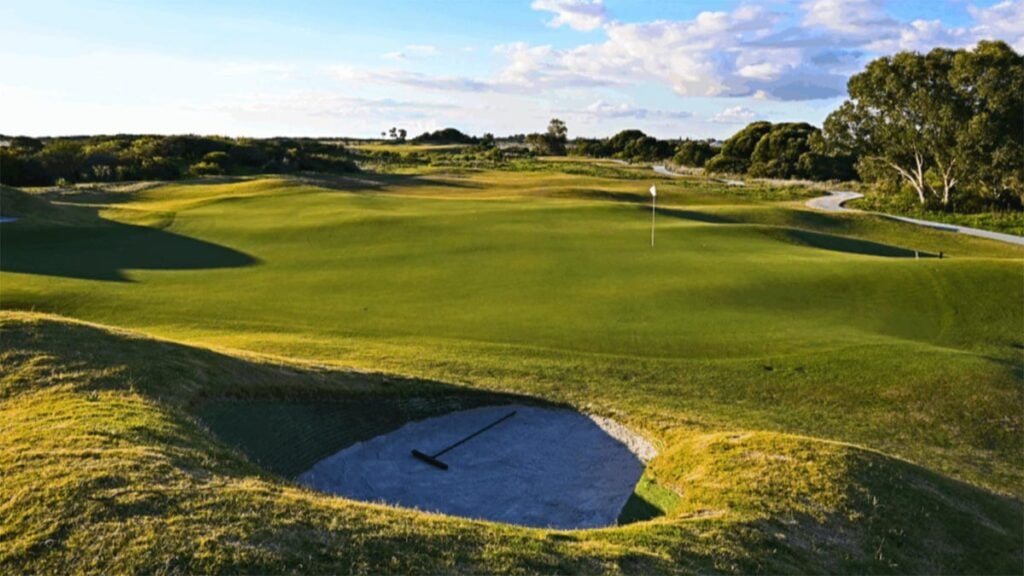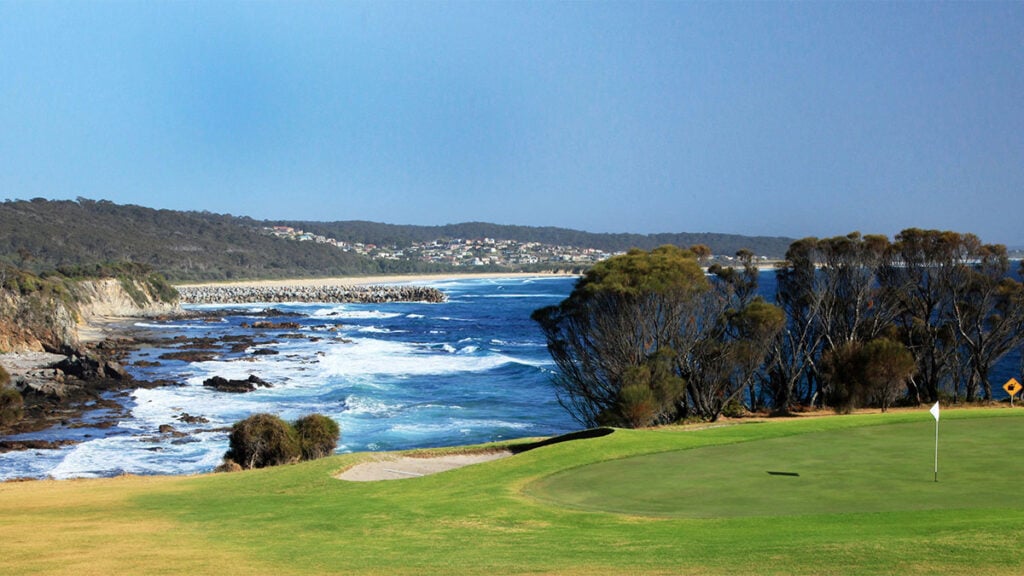This is no April Fools joke. The coronavirus pandemic has displayed the sickening side effect of exposing – even highlighting – the fractured nature of administration of the sport in Australia.
We concede, however, that there is no blueprint for such a situation. Just as Prime Minister Scott Morrison, every premier/chief minister and every health official worldwide is wading through uncharted waters, so too are golf’s caretakers, from governing bodies and turf associations to golf clubs and golfers themselves. This virus arrived with no roadmap to navigate towards a successful outcome.
Yet that’s not to say mistakes aren’t being made. And egregious ones at that.
RELATED: Welcome to golf’s “The Benny Hill Show”
Now feels like a perfect time for golf’s administrators to unite for a common cause, but all we’re hearing are splintered, conflicting and confusing messages. Again.
Financial records show Golf NSW is sitting on $8.5 million in its coffers in cash and cash equivalents, part of $11 million in total assets. The body has contributed $100,000 of that towards bushfire relief after the summer’s devastating fires that ravaged so many golf courses – a welcome yet somewhat frugal gesture. So far there has been no indication of relief for the state’s golf clubs impacted by closure as a result of COVID-19.
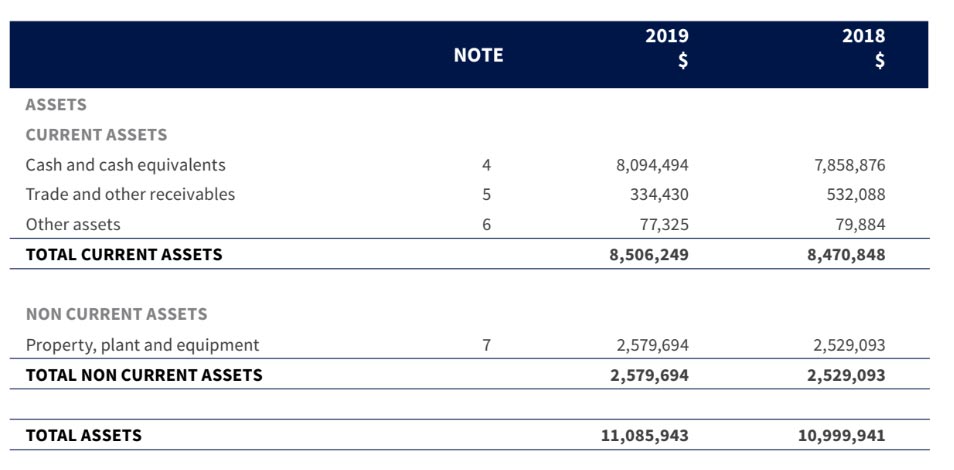
It begs the question: if bushfires and global virus pandemics that place the state’s golf clubs under severe financial hardship are not worthy of dipping deeper into the war chest of funds, then what will it take?
The answer, sadly, is the same malady that plagues so many corporations: executive self-preservation. Only last month, Golf Australia chief executive Stephen Pitt stood down citing the governing body’s poor fiscal performance for the past year or so. How might it look when the financial year closes and Golf NSW chief executive Stuart Fraser is at the helm when that $8.5 million suddenly shows up on the balance sheet as $7.5 million or $6.5 million instead? Not one chief executive of any company wants to be left chair-less when the music stops.
All of which misses the point – something golf is only too familiar with. Golf Australia, Golf NSW and all the governing bodies should not be about financial accumulation but supporting, protecting and improving the sport here. That $8.5 million? It’s not Golf NSW’s money – it’s yours (for golfers in that state). It’s likewise with much of Golf Australia’s incoming funds. As members of Australian golf clubs, you pay affiliation fees to these bodies – all 380,000 of us. It’s not money to be hoarded away; it’s to be used (granted, in a careful fashion) towards the betterment and preservation of the game as we know it.
It’s a point worth reiterating: if a situation like this pandemic isn’t worthy of dishing out some financial support to keep clubs afloat, when is?
In the minds of many golfers, the monetary element of the COVID-19 pandemic perhaps takes a back seat to the impact sitting closer to the forefront: can we keep playing?
Money aside, here’s where the game’s bodies are falling short. While some are acting on advisement from governments (a diplomatically wise move, one that essentially absolves Golf Australia and co. of any responsibility should things go pear-shaped), the contradicting statements are head-shakers.
On Monday afternoon when Golf Australia chairman Andrew Newbold ‘recommended’ – not demanded – golf courses should shut, the PGA of Australia’s chief executive Gavin Kirkman circulated a memo to its members stating the exact opposite message: golf can go on under the right social-distancing practices.
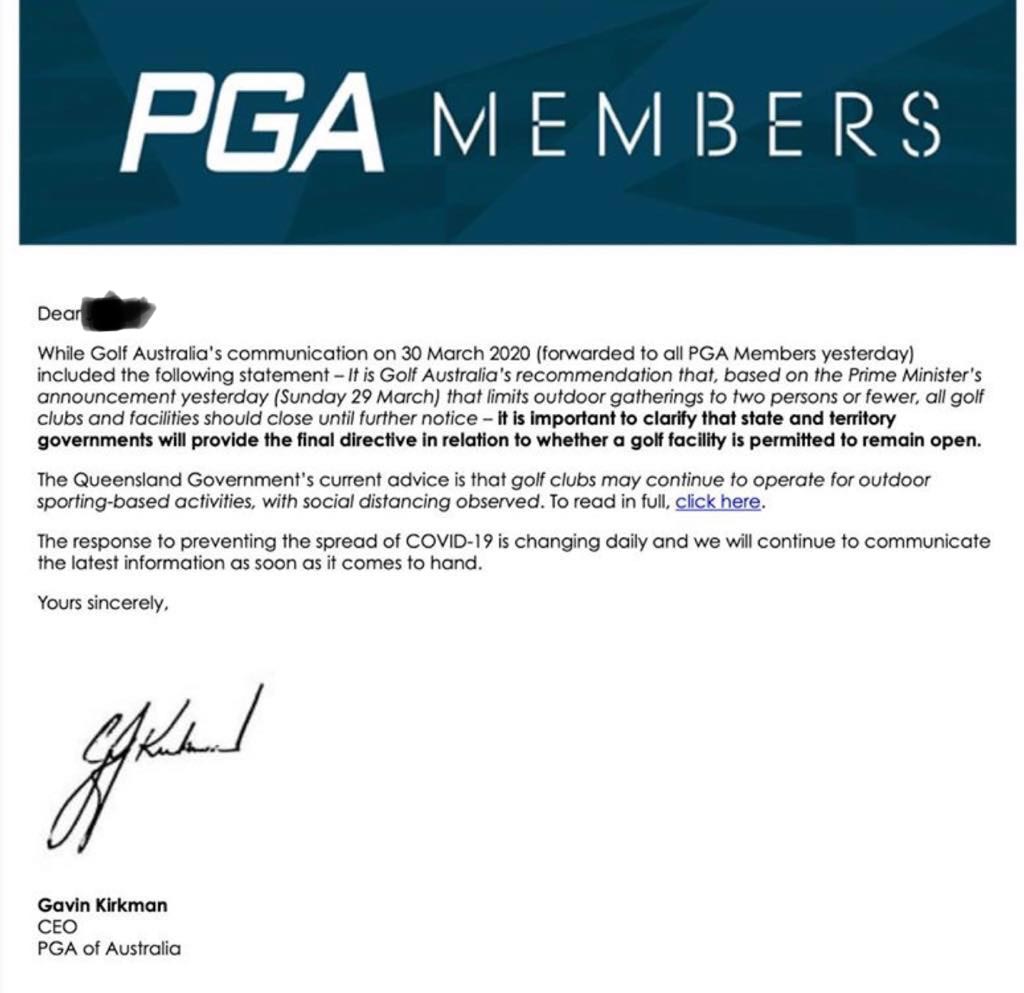
We saw it throughout last week and into this: different states and different clubs taking different stances. It began with Queensland being the odd state out last week by denying play on the grounds of licensing restrictions that it said covered golf courses as well as golf clubs. That decision was later reversed, to the joy of all golfers in the Sunshine State. Then Victoria flipped, recommending last Friday courses close right before an autumn weekend of magnificent weather. Already this week, NSW, which had initially been of the ‘play on’ mindset, on Monday moved across to the ‘shut the courses’ camp only for a revised decision to be handed down from Premier Gladys Berejiklian last night that will allow play again from today.
Such confusion is everywhere. In Tasmania, the least-impacted state and one where community transmission is yet to occur, Premier Peter Gutwein even specifically referenced golf as permissible – in twosomes – under the “exercising” clause of Scott Morrison’s Sunday night edict. But that didn’t sit well with all clubs. Launceston Golf Club announced late yesterday it was closing its course. Yet across town, Riverside Golf Club implored its members and visitors to keep playing via an ardent Facebook post that mirrors the stance of many mainland clubs:
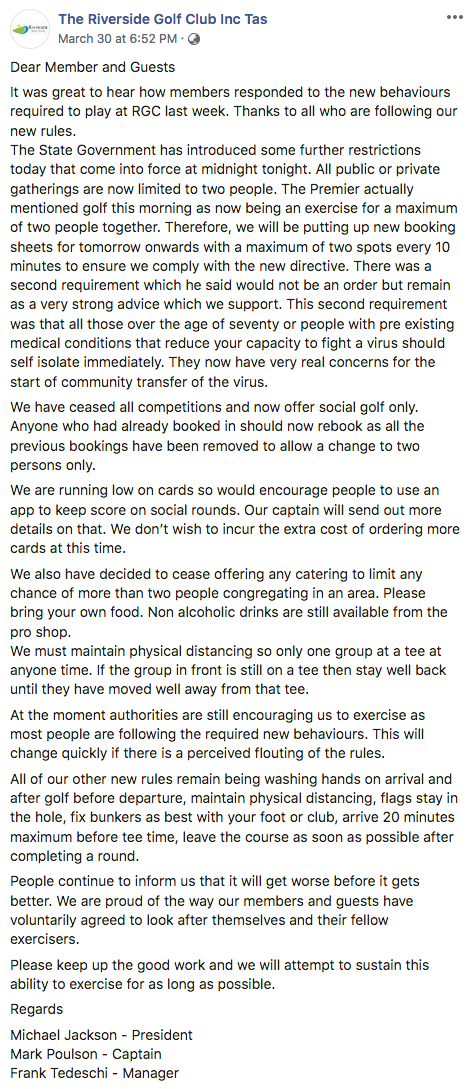
Back in NSW, yesterday morning the police were called to The Vintage Golf Club in the Hunter Valley after a resident in the estate there, under the impression that golf was banned, thought it necessary to call in the authorities.
While perhaps heavy-handed, such concern remains valid because the virus is spreading and touching golf. James Kwan, the first Australian to die from coronavirus when he passed at age 78, was a long-time member of The Vines Resort & Country Club outside Perth.
In Melbourne, a member of esteemed Metropolitan Golf Club contracted COVID-19 elsewhere then visited the club a day after being in contact with someone who unknowingly had the virus. Their contact at the Sandbelt club was not deemed to be close and the member did not show any symptoms until days after their visit, however the situation was serious enough for club captain Richard Galloway to inform the broader membership.
Judging by the thousands of comments sent to Australian Golf Digest directly and on our Facebook page, there are two distinct schools of thought. Much like broader society, golfers are falling into either a ‘golf can be considered exercising’ or a ‘just stay home’ mindset.
The first group cites points such as:
- Golf in twosomes is safer and offers fewer touch points than visiting the supermarket;
- Golf is a terrific form of gentle exercise;
- Golf is imperative for sound mental health;
- What about the financial ramifications of clubs closing – and the impact on courses not permitted to be maintained?
- And even: if golf is the only sport left standing, it will draw more people to the game.
While the latter say:
- The sooner we get everyone indoors and staying at home, the sooner this whole episode passes;
- Protect golf-club staff by closing everything;
- Golf has an older demographic – the very people most at risk to COVID-19;
- And: it’s simply not a good look for just one sport to be permitted to continue.
Strong cases can be made for both stances, which is part of the problem.
Golf in Australia would do well to recall 1996 and the period of uncertainty after the Port Arthur massacre and the debate over gun control in this country. I vividly recall a televised debate over the matter when both sides had their say. Amid all the fervent and fiery grandstanding came a perfectly on-point line from columnist and author Peter FitzSimons. For one known for his verbosity in front of a camera, he was deliciously succinct on this occasion when he said, “It’s simple: more guns equals more danger, fewer guns equals less danger.”
This is golf’s Port Arthur moment – a time when both sides of a passionate debate are entitled to their viewpoint but ultimately the most sensible option has to be the more conservative one. It’s the safest move for all.
RELATED: Why I kept playing (and why I’ve now stopped)

